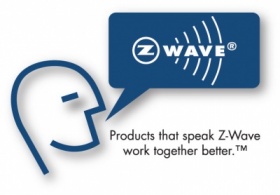Z-Wave radio Technology
From eedomus - Documentation

Contents |
Origin
The Z-Wave radio technology has emerged in Denmark, and now firmly established in the United States and owned by Sigma Designs.
The evolution of the protocol is managed by the Z-Wave alliance.
Features
The technology works on the 868MHz bandwith in Europe. The frequency is different in other countries like the U.S.A. or Australia and New Zealand.
This bandwidth is fairly clear, because the devices should not use more than 1% of the time (unlike the band WiFi or Bluetooth, which can be 100% occupied). The power used is usually 1 mW (wifi has a power of 500 mW).
Radio communications are subject to blind spots. Even the GSM or WiFi may be unreachable in some parts of an apartment.
To enhance wireless range, the Z-Wave supports "mesh" transmissions : routing devices (generally those that are not battery powered) can relay the signal so it reach it's final destination. This "repeating" feature work regardless the manufacturer of the Z-Wave device.
Interoperability
Interoperability of Z-Wave technology is excellent. Of course, devices have to share the same frequency (European frequency or North America frequency for example) to work together.
If the device is already registered by the eedomus team, it's features, images, units, are automatically setup in your interface. See Advanced_Z-Wave#Introduction
Hundreds of devices have been registered. The list of registered devices is available here: Z-Wave_devices_list
Z-Wave Plus and Z-Wave Secure
The eedomus+ gateway supports Z-Wave Plus technology. It offers superior range, while remaining compatible with the older Z-Wave devices.
Security Enabled Z-Wave Plus eedomus controller allows encrypted radio communications between two devices that support this feature. It is a requirement for connecting doorlocks for example.
Secured communications have many advantages (privacy, less radio error), but also some drawbacks (longer communications, thus shorter battery life).
Image on the right: you see at the bottom of the configuration of the device (in Expert parameters) the type of the inclusion
Advanced settings
The devices are configured with their best settings during the inclusion process with eedomus. Powered devices (sockets) are polled every minute to get their status if they don't automatically send it. Battery devices can only be reached by the eedomus gateway during their wakeup time (Generaly setup to 30 minutes)
You may use advanced parameters depending on your needs. Description is available in the documentation for each device.
Two important parameters: the Wake-Up and Polling
- the battery-powered devices send their status every 30 minutes (this is called the "wake up", which is configurable on your eedomus interface).
- the network-powered devices (such as sockets) are polled by eedomus every X minute to refresh their status (This delay is configurable in your eedomus interface)
We recommand to remain reasonnable on wake up frequency (because it reduces the battery life) and polling (it overload the network, which may lead to packet loss).
Learn more on the advanced Z-Wave page
Battery life
Battery life varies from 8 to 24 monthes or more, depending on the usage and the device. Each device gives an average battery life. The duration depends of the number of triggers (especially for PIR, Opening detector).
The battery life of new devices if much better than the first devices on the market.
Other protocols
The various protocols are not interoperable between them (Zigbee, EnOcean, Z-Wave, Bluetooth).
Nevertheless, they can coexist, even if they use the same frequency (EnOcean, Z-Wave in Europe use both 868 MHz).
Please check one of the Z-Wave logo on your devices.







